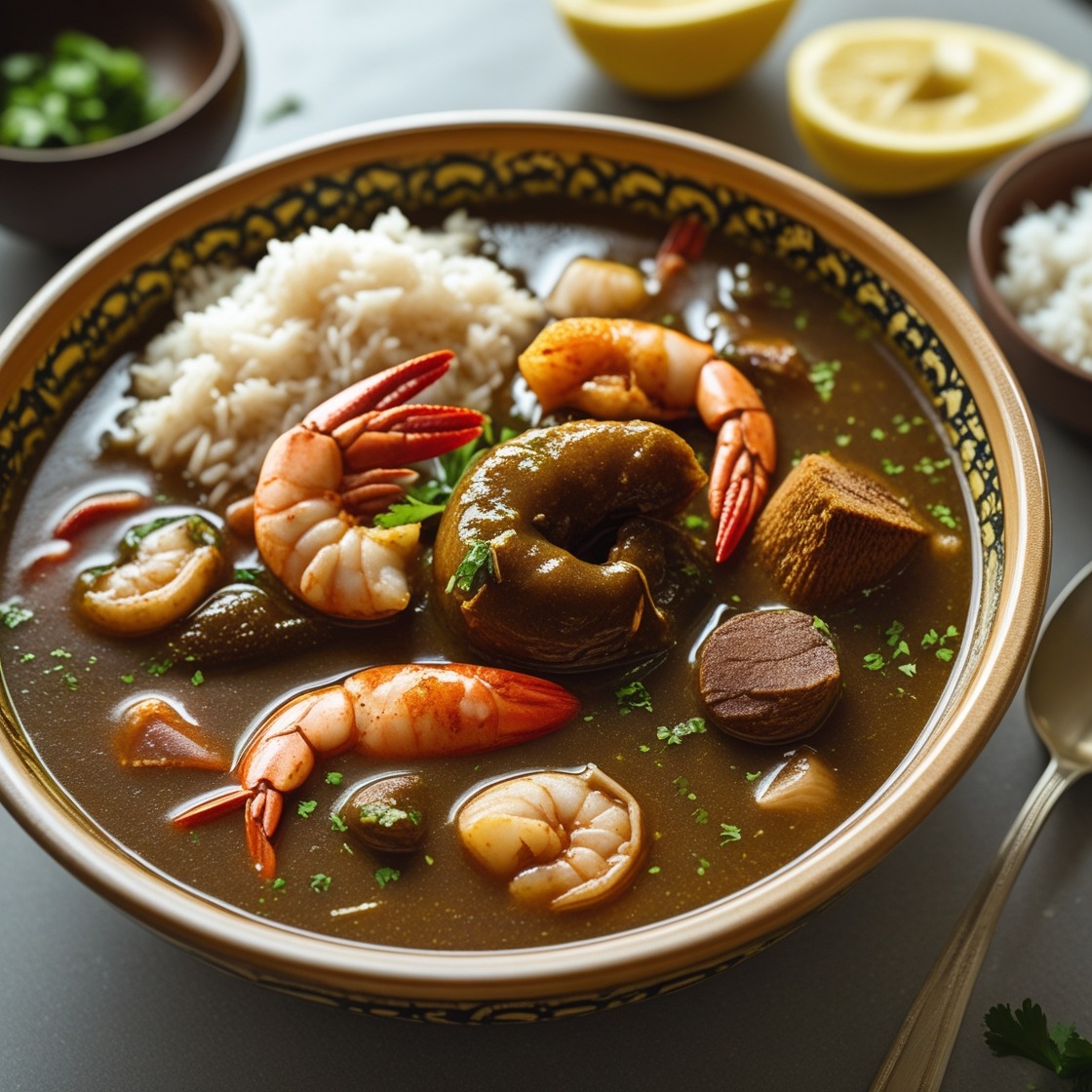When was the last time you experienced the rich, soul-warming taste of a truly authentic dish? Imagine a recipe that’s more than just food—it’s a story, a celebration of culture, and a connection to generations past. Welcome to the world of Creole gumbo, a culinary treasure that has stood the test of time.
From its roots in Louisiana to kitchens around the world, Creole gumbo is a dish that combines bold flavors, fresh ingredients, and a deep sense of tradition. Whether you’re new to this iconic recipe or looking to perfect your technique, this guide is here to take you on a flavorful journey.
In this blog, we’ll uncover what makes a Creole gumbo recipe truly exceptional. You’ll learn the secrets to its signature roux, the perfect blend of spices, and the art of balancing seafood, sausage, and okra in every bite. Ready to master a dish that brings people together and leaves a lasting impression? Let’s dive in.
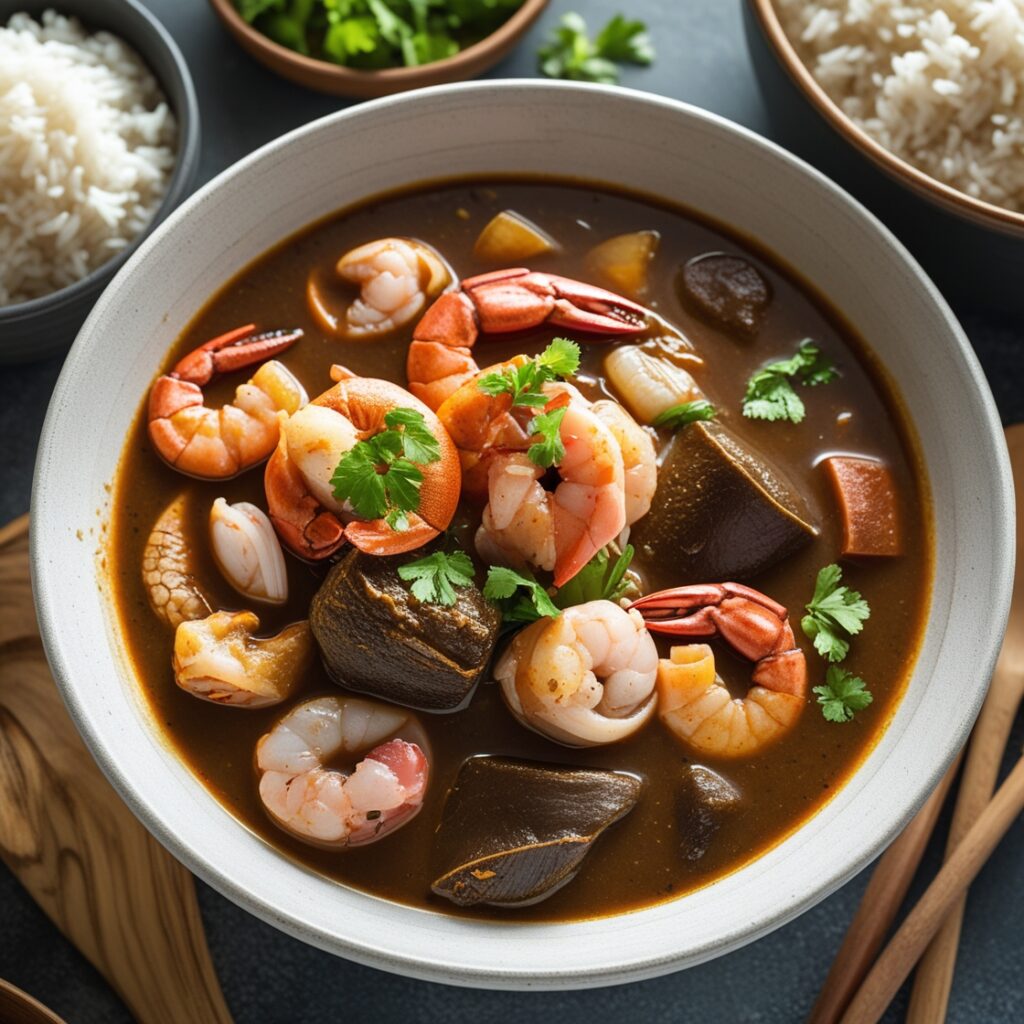
Table of Contents
The Heart of Creole Gumbo: What Makes It So Special?
If you’ve ever tasted a bowl of Creole gumbo, you know it’s not just a meal—it’s an experience. But what exactly makes this dish so extraordinary? Let’s break it down into its key elements, so you can understand why it’s a favorite in kitchens and restaurants worldwide.
1. The Soul of the Dish: A Perfect Roux
At the heart of every Creole gumbo recipe is the roux—a carefully cooked mixture of flour and fat that gives the dish its signature depth and richness. The secret? Patience. Achieving that deep, nutty brown color takes time, but trust me, the payoff is worth it.
Here’s why it matters:
- The roux acts as the foundation, thickening the gumbo and adding layers of flavor.
- It sets the tone for the entire dish—too light, and it lacks complexity; too dark, and it can taste bitter.
Pro tip: Stir constantly over low to medium heat. This ensures an even color and prevents burning.
2. Fresh, High-Quality Ingredients
Gumbo is a celebration of fresh ingredients, and the quality of what you use can make or break the dish. Key components include:
- Seafood: Shrimp, crab, or oysters add a briny, savory flavor.
- Sausage: Andouille sausage brings a smoky kick.
- Vegetables: The “holy trinity” of Creole cooking—onions, bell peppers, and celery—creates a fragrant base.
Remember, it’s all about balance. Each ingredient plays a role, but none should overpower the others.
3. The Perfect Seasoning Blend
Creole gumbo is known for its bold, zesty flavors, and the seasoning is where the magic happens. While recipes can vary, a good mix often includes:
- Cayenne pepper for heat
- Paprika for smokiness
- Thyme and bay leaves for earthy undertones
Tip: Taste as you go! A little adjustment can make a big difference in the final flavor.
4. The Role of Tradition
What sets gumbo apart is the love and history poured into every pot. Each recipe is a reflection of the cook’s heritage and creativity. From family secrets to regional variations, every bowl tells a story.
So, whether you’re learning to cook Creole gumbo for the first time or refining your skills, know that you’re carrying on a tradition that has brought joy to countless tables.
Ready to bring this masterpiece to life in your kitchen? It starts with understanding the essentials and adding your personal touch. After all, the best gumbo isn’t just delicious—it’s uniquely yours.
Mastering the Art of Cooking Creole Gumbo at Home
Cooking Creole gumbo at home may feel like a challenge, but with the right approach, it’s an enjoyable and rewarding experience. Whether you’re a seasoned cook or new to the kitchen, understanding the process step-by-step can turn your gumbo into a masterpiece. Let’s explore how you can perfect this iconic dish.
1. Gather Your Ingredients Like a Pro
Before diving in, preparation is key. Having everything measured and ready ensures a smooth cooking experience. Here’s a basic checklist to guide you:
- Protein: Shrimp, crab, chicken, andouille sausage—or a mix!
- Vegetables: Onion, bell pepper, celery (the holy trinity) along with fresh okra.
- Broth: A rich homemade stock (seafood or chicken) takes your gumbo to the next level.
- Spices: Cayenne, paprika, garlic powder, and thyme for authentic Creole flavor.
- Roux Ingredients: Equal parts flour and oil or butter.
Shopping tip: Opt for fresh seafood and high-quality sausage for the best results.
2. Perfecting Your Roux: The Cornerstone of Creole Gumbo
Making a roux can seem intimidating, but it’s easier than you think when broken into simple steps:
- Heat oil or butter in a heavy-bottomed pot over medium heat.
- Gradually whisk in the flour until fully combined.
- Stir continuously until the roux reaches a deep brown color, akin to chocolate.
Patience is your friend here. A perfectly cooked roux is the backbone of any Creole gumbo recipe, adding depth and texture to your dish.
3. Layering Flavors Step-by-Step
One secret to a great gumbo lies in layering flavors. Here’s how you can do it effectively:
- Sauté Aromatics: Cook your onions, bell peppers, and celery in the roux until softened.
- Add Proteins Gradually: Brown sausage first, then fold in seafood near the end to prevent overcooking.
- Simmer with Spices: Allow the broth and seasonings to meld together for at least 45 minutes.
4. Tips for the Perfect Texture
Texture is crucial in gumbo. Here are some tricks to achieve that luscious, hearty consistency:
- Use okra as a natural thickener, or try filé powder (ground sassafras leaves) for added depth.
- Avoid overcooking seafood—it should be tender, not rubbery.
- Let the gumbo rest after cooking to allow the flavors to deepen.
5. Making It Your Own
While tradition is important, every cook adds their unique twist to gumbo. Experiment with:
- Spice levels: Prefer it mild or extra fiery? Adjust the cayenne to suit your taste.
- Additional ingredients: Add tomatoes for a Creole twist or leave them out for a more Cajun-style gumbo.
- Garnishes: Serve over rice and top with chopped green onions or parsley for a fresh finish.
Cooking gumbo isn’t just about following a recipe—it’s about creating something that feels personal. With each pot you make, you’ll discover new ways to enhance the flavors, tweak the spices, and make it truly your own. So grab your apron and get ready to enjoy a taste of Creole tradition right in your own kitchen!
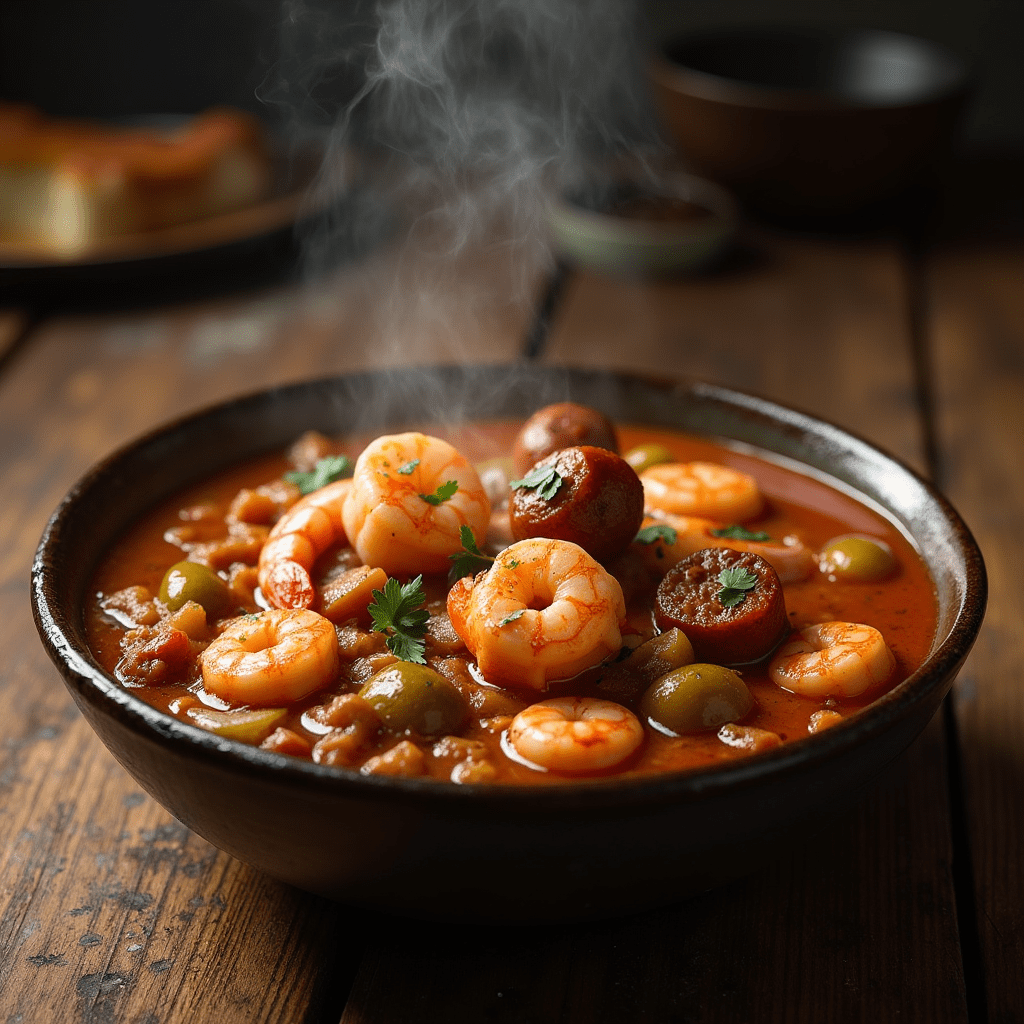
Serving and Enjoying Your Creole Gumbo
After perfecting your Creole gumbo recipe, the final step is serving it in a way that enhances the experience. Presentation, accompaniments, and the right ambiance can elevate your dish from delicious to unforgettable. Let’s talk about how to make every bite as memorable as the effort you’ve put in.
1. Choosing the Right Sidekicks
What’s gumbo without its classic pairings? The right sides can complement its bold flavors perfectly. Here are some staples to consider:
- Steamed Rice: The traditional base that absorbs the savory broth beautifully. For extra flair, try jasmine or brown rice.
- Crusty French Bread: Perfect for soaking up every last drop of that flavorful gumbo.
- Potato Salad: Believe it or not, some locals enjoy a dollop of creamy potato salad on the side—or even mixed directly into the gumbo!
These options let your guests customize their meal to their liking.
2. Plating Like a Pro
Presentation matters, even with a hearty dish like gumbo. A well-served bowl invites your guests to dive in with anticipation. Follow these tips:
- Use deep bowls to hold both the gumbo and its broth without spills.
- Place a mound of rice in the center and ladle the gumbo around it for a restaurant-style touch.
- Garnish with chopped green onions or a sprinkle of parsley for a pop of color.
A visually appealing plate adds to the joy of the meal.
3. Creating the Perfect Atmosphere
Gumbo is more than food—it’s an experience. Why not set the mood to match?
- Play some Louisiana jazz or zydeco music to transport everyone to the heart of Creole culture.
- Opt for communal dining to encourage conversations, laughter, and sharing—a true Creole tradition.
- Add some rustic tableware or serve family-style in a big pot to emphasize its homely, comforting vibe.
The ambiance should complement the warmth and soul of the gumbo itself.
4. The Joy of Leftovers
One of the best things about gumbo? It tastes even better the next day. As the flavors meld overnight, they become richer and more complex. Here’s how to store and reheat your gumbo for maximum enjoyment:
- Refrigerate in an airtight container for up to 3 days.
- Freeze in individual portions if you’ve made a large batch—it reheats beautifully.
- To reheat, warm it gently on the stove over low heat, stirring occasionally to maintain its texture.
Your future self will thank you for saving some of that goodness!
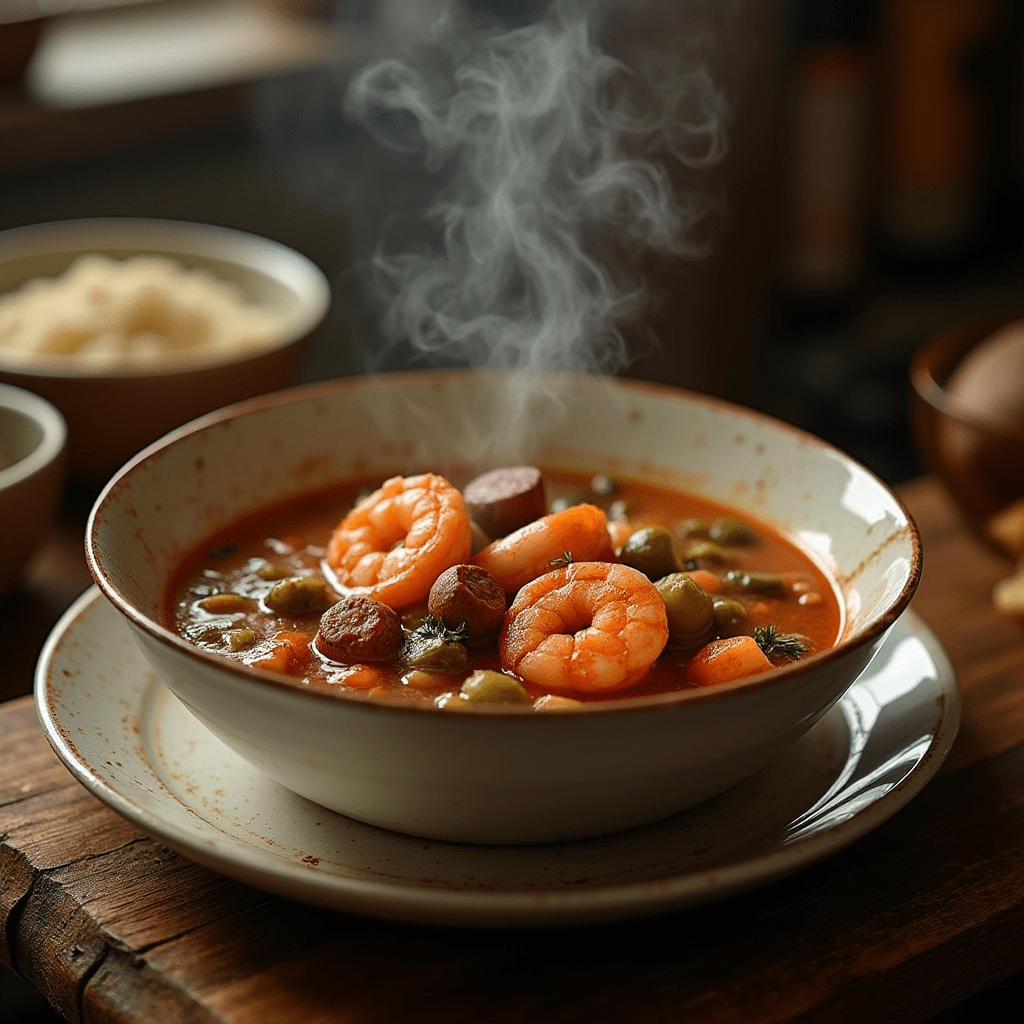
5. Sharing the Experience
Finally, Creole gumbo is meant to be shared. Whether it’s a cozy family dinner or a festive gathering, this dish has a way of bringing people together. Encourage your guests to serve themselves, add their favorite toppings, and enjoy the communal spirit of gumbo.
And don’t forget to share your journey with others. Whether you pass along the recipe or post your creation online, celebrating your success inspires others to try their hand at this cherished dish.
Creole gumbo isn’t just a meal—it’s an invitation to connect, savor, and celebrate. So, as you serve that first steaming bowl, take a moment to appreciate the love and history behind it. You’ve not only created a dish but a memory that will linger long after the meal is done.
Tips for Elevating Your Creole Gumbo Recipe
Now that you’ve mastered the basics of making Creole gumbo, let’s explore how to take your dish to the next level. Whether you’re cooking for a dinner party or perfecting it for your family, small tweaks can make a world of difference. Ready to become a gumbo connoisseur? Let’s dive in!
1. Customize the Flavor Profile
One of the best things about gumbo is how versatile it can be. Here are some ideas to tailor the flavors to your liking:
- Heat Level: Love spicy food? Add extra cayenne pepper or hot sauce to amp up the heat. For a milder version, reduce the spices and focus on herbs like thyme and parsley.
- Seafood Swap: Experiment with different types of seafood like crawfish or scallops for a unique twist.
- Smoky Depth: Try smoked paprika or liquid smoke for an added layer of complexity.
Every small change allows you to make this classic recipe uniquely yours.
2. Use High-Quality Ingredients
Premium ingredients can transform a good gumbo into a great one. Here’s what to prioritize:
- Seafood: Look for fresh, wild-caught shrimp and crab for the best flavor.
- Sausage: Authentic andouille sausage adds a smoky, spicy kick that’s hard to beat.
- Spices: Invest in fresh, high-quality seasonings to ensure bold, vibrant flavors.
Remember, the better the ingredients, the richer the final dish.
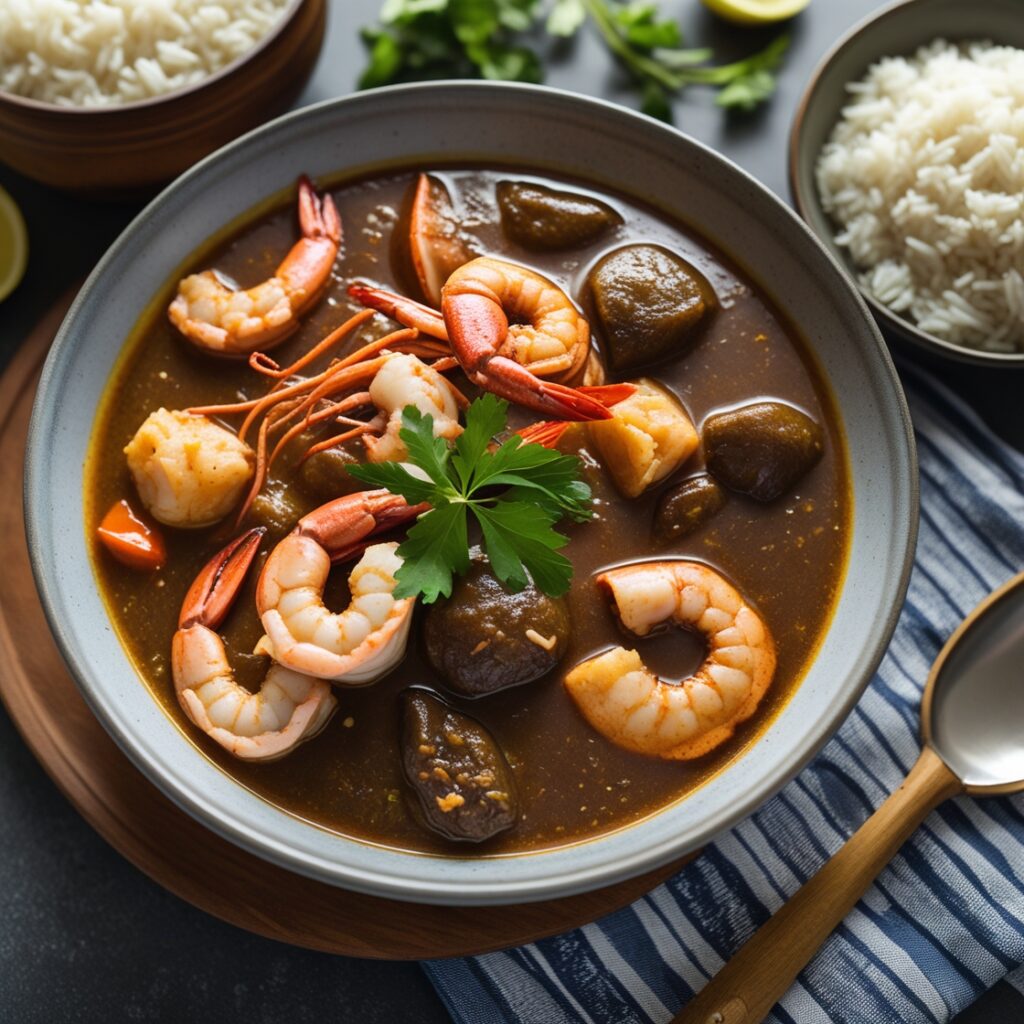
3. Experiment with Add-Ins
Looking to get creative? Incorporate unique ingredients to give your gumbo a personal touch. Consider these options:
- Tomatoes: For a Creole-style gumbo, diced tomatoes add brightness and acidity
- Sweet Corn: For a hint of sweetness and texture, fresh kernels work beautifully.
These add-ins are subtle yet impactful, elevating the overall dish without overpowering the traditional flavors.
4. Cook Low and Slow
Gumbo is not a dish to rush. Here’s why patience is a virtue when making it:
- Flavor Fusion: Slow cooking allows the spices, proteins, and vegetables to meld beautifully.
- Perfect Texture: A low simmer helps achieve that velvety broth without overcooking any ingredients.
Set aside plenty of time, and enjoy the process—it’s part of what makes gumbo so special.
5. Serve with Creativity
Elevate your presentation with thoughtful serving ideas. Here’s how:
- Create a self-serve gumbo bar with bowls of rice, chopped herbs, hot sauce, and lemon wedges for guests to customize their meal.
- Pair gumbo with a side salad or cornbread for a well-rounded dining experience.
These small details can transform your meal into an unforgettable event.
6. Keep Learning and Innovating
No matter how many times you make gumbo, there’s always room to refine your technique. Try these strategies:
- Seek Feedback: Ask family or guests what they loved most and where you could improve.
- Explore Variations: Dive into regional gumbo recipes for inspiration, such as Cajun-style or seafood-only versions.
- Practice Makes Perfect: The more you cook, the better you’ll get at perfecting every element of this dish.
Gumbo is as much an art as it is a recipe. With each pot, you’ll gain more confidence and skill, creating a signature version that’s truly your own.
Creole gumbo is more than just a recipe—it’s an evolving culinary adventure. By experimenting with flavors, embracing quality ingredients, and cooking with care, you can create a dish that’s as personal as it is delicious. So don’t be afraid to try new things and, most importantly, enjoy the process. After all, the magic of gumbo lies not just in the taste but in the love and creativity behind it.
Celebrating the History and Culture Behind Creole Gumbo
Creole gumbo is more than just a flavorful dish—it’s a reflection of rich history and diverse cultural influences. Every bite tells a story of resilience, creativity, and community. Let’s take a moment to explore the origins and significance of this iconic recipe, so you can fully appreciate its place at the table.
1. A Melting Pot of Cultures
Gumbo embodies the cultural fusion that defines Louisiana. Its origins can be traced to a blend of influences from:
- West Africa: Okra, the name itself derived from the word “ki ngombo,” was introduced by African slaves.
- French: The technique of making a roux comes from French culinary traditions, adding richness to the dish.
- Spanish: The inclusion of peppers and tomatoes reflects Spanish influence.
- Native American: Filé powder, made from ground sassafras leaves, was a contribution from indigenous peoples.
Each culture brought something unique, making gumbo a true representation of Creole heritage.
2. The Evolution of Gumbo
Did you know that gumbo recipes evolved based on the ingredients available to each community? Here’s how the dish has transformed over time:
- In coastal areas, seafood gumbo dominated, featuring shrimp, crab, and oysters.
- Inland regions favored meat-based versions with chicken and andouille sausage.
- Over the years, gumbo has also seen modern twists, with chefs adding unique spices or experimenting with plant-based variations.
This adaptability has kept gumbo relevant while honoring its roots.
3. Gumbo’s Role in Community and Celebration
Gumbo isn’t just a meal; it’s a symbol of togetherness. Historically, it was often prepared for:
- Family Gatherings: Large pots were shared during family events, bringing everyone closer.
- Festivals and Holidays: Gumbo is a staple at Mardi Gras celebrations, showcasing Louisiana’s festive spirit.
- Everyday Comfort: Beyond special occasions, gumbo is the ultimate comfort food, warming hearts and stomachs alike.
The communal aspect of gumbo-making—where everyone contributes—adds to its charm.
4. Protecting the Tradition
With its deep cultural roots, gumbo is more than just a dish—it’s a legacy worth preserving. Here’s how you can help keep the tradition alive:
- Pass It Down: Share your recipe and techniques with the next generation, just as many families have done for centuries.
- Support Local Chefs: Visit restaurants in Louisiana to taste authentic gumbo and support local culinary artists.
- Educate Yourself: Learn about the history of Creole cuisine to deepen your appreciation for its significance.
By celebrating gumbo’s heritage, you become part of the story, ensuring it continues to thrive.
5. Why Gumbo Matters Today
In today’s fast-paced world, gumbo serves as a reminder to slow down and savor the connections we share over a meal. It’s a dish that transcends boundaries, bringing together people of all backgrounds to enjoy a rich cultural tradition.
By cooking and sharing Creole gumbo, you’re not just making dinner—you’re honoring a legacy, embracing diversity, and creating memories that will last for years to come.
Creole gumbo is a culinary treasure, woven into the fabric of Louisiana’s history and culture. Every pot tells a story, and every cook adds a new chapter. So as you savor your next bowl of gumbo, take a moment to reflect on the journey it has traveled to reach your table. It’s not just food; it’s a celebration of heritage, love, and community.
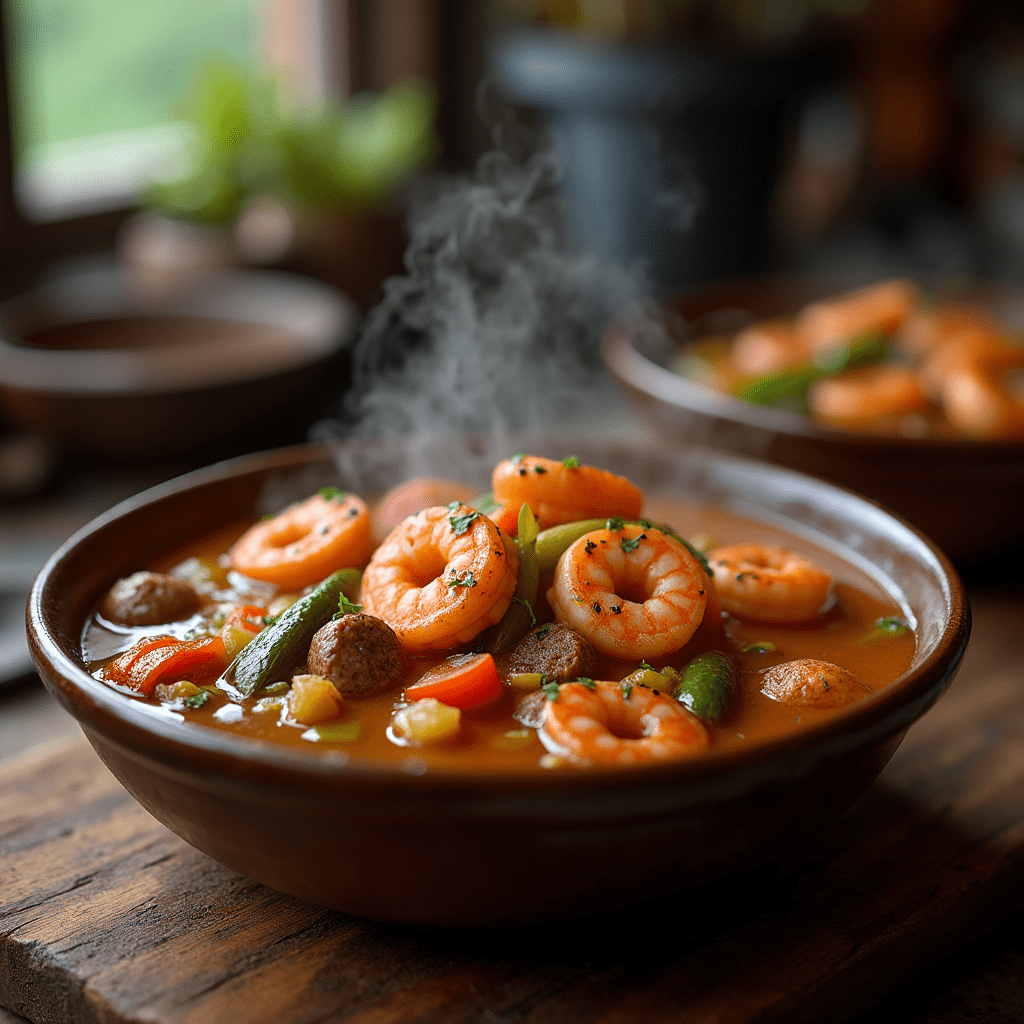
Conclusion: Your Creole Gumbo Adventure Awaits
As we’ve explored, Creole gumbo is more than just a dish—it’s a journey through history, culture, and flavor. Whether you’ve made it a few times or are preparing to cook it for the first time, the beauty of gumbo lies in its adaptability and the personal touch you bring to each pot.
So, what are you waiting for? Gather your ingredients, embrace the art of the roux, and infuse your gumbo with flavors that reflect your unique tastes. And remember, this isn’t just about following a recipe—it’s about creating something that tells your own story.
From experimenting with spices to learning the history behind this beloved dish, every step is an opportunity to connect with a centuries-old tradition while making it your own. Whether you’re cooking for family, friends, or just for yourself, a bowl of Creole gumbo is a reminder of the joy that comes from sharing a meal.
So, take pride in every spoonful and know that you’re part of something much bigger—a celebration of community, heritage, and, of course, delicious food. The next time you sit down to enjoy your homemade gumbo, savor not only the flavors but the memories you’re creating.
Creole gumbo is waiting for you to make it your own—are you ready to dive in?
Frequently Asked Questions about Creole Gumbo
If you’re diving into the world of Creole gumbo, you might have a few questions. Don’t worry—we’ve got you covered! Below, we’ve answered some of the most common questions to help you make the best gumbo possible, whether you’re a seasoned cook or trying it for the first time.
1. What’s the difference between Creole gumbo and Cajun gumbo?
Great question! Both Creole and Cajun gumbo are staples of Louisiana cuisine, but they have some key differences:
- Creole Gumbo typically uses a tomato-based broth and tends to feature a mix of seafood (like shrimp, crab, and oysters) and meat (like chicken or sausage). It’s often a bit more refined in flavor.
- Cajun Gumbo, on the other hand, usually has a darker, richer roux and focuses more on meat (like sausage or duck), with less emphasis on tomatoes and seafood.
While both are delicious, Creole gumbo offers a more coastal, tomato-forward profile.
2. Can I make gumbo ahead of time?
Absolutely! In fact, gumbo often tastes even better the next day as the flavors have more time to meld together. Here are some tips:
- Refrigerate: Once your gumbo has cooled, store it in an airtight container in the fridge for up to 3 days.
- Freeze: You can freeze gumbo for up to 3 months, but be sure to let it cool completely before storing.
When reheating, just bring it to a gentle simmer on the stove to ensure the flavors are just as vibrant as when it was first made.
3. How can I make my gumbo spicier?
If you’re a fan of heat, there are a few easy ways to kick up the spice in your Creole gumbo:
- Cayenne Pepper: Add more cayenne pepper to the base for that signature heat.
- Hot Sauce: A few dashes of your favorite hot sauce can really bring the spice to life.
- Spicy Sausage: Opt for a spicier andouille sausage to add both flavor and heat to the dish.
Don’t forget to taste as you go so you can control the heat level to your liking.
4. Can I make a vegetarian version of Creole gumbo?
Yes, you can! Gumbo is highly adaptable, and a vegetarian version can be just as hearty and flavorful. Here’s how:
- Vegetable Stock: Replace the chicken or seafood stock with a rich vegetable stock.
- Plant-Based Proteins: Swap in plant-based proteins like tempeh or tofu, or load up on mushrooms for a meaty texture.
- Veggies Galore: Add in a variety of vegetables like okra, bell peppers, tomatoes, and corn to build flavor and texture.
Even without meat or seafood, your gumbo can still deliver on richness and complexity.
5. What kind of rice is best for gumbo?
Traditionally, long-grain white rice is the go-to for gumbo, as it holds up well when mixed with the broth. However, you can get creative with rice options:
- Brown Rice: For a healthier alternative with a bit more texture.
- Jasmine Rice: Adds a subtle floral aroma that pairs wonderfully with the bold flavors of gumbo.
Whichever rice you choose, the key is ensuring it’s cooked just right to absorb that flavorful broth.
6. What is a roux, and why is it important in gumbo?
A roux is a mixture of fat (usually butter or oil) and flour, and it’s the foundation of a great gumbo. It thickens the broth and gives the gumbo its rich, velvety texture. Here’s how to make the perfect roux:
- Low and Slow: Heat the fat and flour over medium heat, stirring constantly to prevent burning. The longer you cook the roux, the darker and more flavorful it becomes.
- Roux Shades: For Creole gumbo, a medium-brown roux is ideal—it adds depth without overpowering the other ingredients.
The roux is a crucial step, so don’t rush it—it’s worth the time and patience.
7. Can I add different types of meat or seafood?
Definitely! Creole gumbo is a versatile dish, and you can tailor it to your preferences. Some popular variations include:
- Chicken & Sausage: A classic combo that balances flavors and textures.
- Seafood-Only: If you’re a seafood lover, go all in with shrimp, crab, oysters, and even crawfish.
- Mixed Meat & Seafood: For the ultimate gumbo, combine both meat and seafood for a dish that’s hearty and flavorful.
The beauty of gumbo is that it can accommodate whatever ingredients you have on hand—just make sure to balance the flavors and textures for a truly satisfying dish.
Creole gumbo is a dish that invites creativity, experimentation, and enjoyment. With these FAQs in hand, you’re ready to dive in and start crafting your own perfect gumbo. Whether you’re adding a personal touch or sticking to tradition, the key is to enjoy the process and savor every delicious spoonful.

